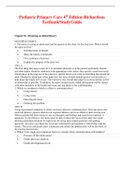Exam (elaborations)
Pediatric Primary Care 4th Edition Richardson Test Bank (All 36 Chapters)
- Course
- Institution
- Book
Pediatric Primary Care 4th Edition Richardson Test Bank (All 36 Chapters) Chapter 01: Obtaining an Initial History Chapter 02: Obtaining an Interval History Chapter 03: Performing a Physical Examination Chapter 04: Making Newborn Rounds Chapter 05: Guidelines for Breastfeeding Chapter 06: Co...
[Show more]



